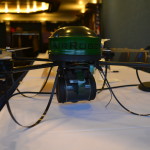WASHINGTON – Law professors, industry experts and civil liberties advocates wrangled over privacy rights and the increasing use of surveillance drones at a symposium at the National Press Club on Tuesday, debating how the government should respond to a growing and controversial technology.
Speakers discussed whether the benefits offered by unmanned aircraft outweigh privacy concerns as use of drones by U.S. law enforcement agencies increases. Though there are more than 600 licensed drones operating across the nation, the Federal Aviation Administration has estimated that up to 30,000 drones could roam U.S. skies by the end of the decade. The figures reflect a rapidly growing technology which some say threatens citizens’ Fourth Amendment protections against unreasonable search and seizure.
“Drones change how we think about public space,” said Laura Donohue, a professor at Georgetown Law School.
Rep. Ted Poe, R-Texas, stressed the need for establishing guidelines in the use of unmanned aircraft, while speaking at the event hosted by the Electronic Privacy Information Center, a Washington-based nonprofit research center that analyzes civil liberties issues. Poe, who is working on legislation to put “sensible limitations” on the use of drones, said it is important to consider their use by both government and private entities.
“Congress should take the lead on this issue, rather than wait for cases and let the courts decide,” Poe said.
Gretchen West, executive vice president for the Association of Unmanned Vehicle Systems International, argued for the value of drones in search and rescue missions. Her organization is the world’s largest nonprofit organization advocating for unmanned vehicle systems.
“The capabilities of unmanned aircraft are virtually limitless,” West said, noting that the growing industry could produce thousands of jobs in the years ahead.
West said an unmanned helicopter used by the Mesa County Colorado Sheriff’s Office since 2009, has flown more than 35 missions with a combined total of 160 flight hours. She also pointed to the use of drones since 2011 in Japan, where the United States helped respond to the Fukushima nuclear disaster. The unmanned helicopters were used to safely measure radiation levels near the nuclear plant, without risking the lives of human beings, she said.
Last year, President Barack Obama signed the FAA Modernization and Reform Act, which created mandates for the FAA to expand government and non-government drone use. The law has since been criticized by civil liberties advocates as too lax in regulating drones.
Commercial use for drones is illegal. But Amie Stepanovich, associate counsel for EPIC, argues that there are many loopholes in the existing laws on drone use.
“There are laws that protect privacy, but those rules don’t work on all drones,” Stepanovich said. “We at EPIC built a model drone that has two HD cameras, and it is a tool, but it can be sold as a toy. The FAA can’t regulate that.”
Bruce Schneier, chief technology officer for BT Counterpane, a company that provides security services to many Fortune 500 companies, also raised questions about security concerns when using unmanned aircrafts. He cited instances where drones have been hacked or infected with a virus, raising potential security concerns for drones used by the government.
“Drones are really just computers,” he said. “They’re mobile computers with the ability to move around on their own. Computers are vulnerable, and drones are, too.”
Julian Sanchez, a research fellow at the libertarian-leaning Cato Institute, urged policymakers and experts to objectively evaluate this new field of technology and its implications.
“We have to systematically look at the drone world and decide if that’s the world we want to live in,” Sanchez said.





